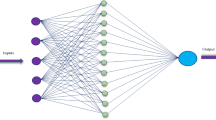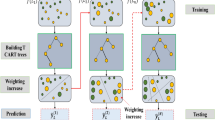Abstract
An effective waste management plan must include reliable building waste generation data. This study seeks to build a trustworthy approach for predicting Construction and Demolition Waste (CDW) generation utilizing limited data. Different optimization algorithms are applied to eXtreme Gradient Boosting (XGBOOST) and compared to standard machine learning models including artificial neural network, support vector regression, and decision tree. The versatility and generalizability of the proposed approach are showcased by utilizing two distinct datasets in the Greater Bay Area of China and Tanta City of Egypt. The developed model reported excellent results, with testing \({R}^{2}\) values equal to 99.9. The research findings may be applied to the strategic development of waste management facilities, monitoring the urban metabolism, creating a circular economy using limited data. The study’s outcomes, as aligned with these 3R principles, lay the foundation for proactive waste management planning, resource optimization, and material valorization in the construction sector. This can potentially foster a more sustainable and circular approach to waste management, promoting a shift towards a more resource-efficient and environmentally conscious construction industry.





Similar content being viewed by others
References
Abdrabo, K. I., Hamed, H., Fouad, K. A., Shehata, M., Kantoush, S. A., Sumi, T., & Osman, T. (2021). A methodological approach towards sustainable urban densification for urban sprawl control at the microscale: Case study of Tanta, Egypt. Sustainability, 13(10), 5360.
Achite, M., Samadianfard, S., Elshaboury, N., & Sharafi, M. (2022). Modeling and optimization of coagulant dosage in water treatment plants using hybridized random forest model with genetic algorithm optimization. Environment Development and Sustainability, 25(10), 11189–11207.
Akanbi, L. A., Oyedele, A. O., Oyedele, L. O., & Salami, R. O. (2020). Deep learning model for demolition waste prediction in a circular economy. Journal of Cleaner Production, 274, 122843.
Asare, W., Oduro-Kwarteng, S., Donkor, E. A., & Rockson, M. A. (2022). Cost-effectiveness of incentive schemes for waste material resource recovery. Cleaner Waste Systems, 2, 100019.
Awad, M., Khanna, R., Awad, M., & Khanna, R. (2015). Machine learning in action: Examples. Efficient learning machines: Theories, concepts, and applications for engineers and system designers (pp. 209–240). Apress.
Bao, Z., Lu, W., Peng, Z., & Ng, S. T. (2023). Balancing economic development and construction waste management in emerging economies: A longitudinal case study of Shenzhen, China guided by the environmental Kuznets curve. Journal of Cleaner Production, 396, 136547.
Berk, J., Nguyen, V., Gupta, S., Rana, S., & Venkatesh, S. (2019). Exploration enhanced expected improvement for Bayesian optimization. In Machine Learning and Knowledge Discovery in Databases: European Conference, ECML PKDD 2018, Dublin, Ireland, September 10–14, 2018, Proceedings, Part II 18 (pp. 621–637). Springer International Publishing.
Brownlee, J. (2021). Optimization for machine learning. Machine Learning Mastery.
Cha, G. W., Choi, S. H., Hong, W. H., & Park, C. W. (2022a). Development of machine learning model for prediction of demolition waste generation rate of buildings in redevelopment areas. International Journal of Environmental Research and Public Health, 20(1), 107.
Cha, G. W., Moon, H. J., & Kim, Y. C. (2022b). A hybrid machine-learning model for predicting the waste generation rate of building demolition projects. Journal of Cleaner Production, 375, 134096.
Cha, G. W., Moon, H. J., Kim, Y. M., Hong, W. H., Hwang, J. H., Park, W. J., & Kim, Y. C. (2020). Development of a prediction model for demolition waste generation using a random forest algorithm based on small datasets. International Journal of Environmental Research and Public Health, 17(19), 6997.
Chen, Z. Y., Zhang, T. H., Zhang, R., Zhu, Z. M., Yang, J., Chen, P. Y., & Guo, Y. (2019). Extreme gradient boosting model to estimate PM2.5 concentrations with missing-filled satellite data in China. Atmospheric Environment, 202, 180–189.
City population (2023). Egypt: administrative division-Governorates and districts. Available online: https://www.citypopulation.de/en/egypt/admin/ (Accessed on 15 Jan 2023)
Economics Commentary (2022). China’s Greater Bay Area becomes key mega region in global economy. Available online: https://www.spglobal.com/marketintelligence/en/mi/research-analysis/chinas-greater-bay-area-becomes-key-mega-region-in-global-economy-June22.html (Accessed on 1 Apr 2023)
Coskuner, G., Jassim, M. S., Zontul, M., & Karateke, S. (2021). Application of artificial intelligence neural network modeling to predict the generation of domestic, commercial and construction wastes. Waste Management & Research, 39(3), 499–507.
Derrible, S., Cheah, L., Arora, M., & Yeow, L. W. (2021). Urban metabolism. The Urban Book SeriesIn W. Shi, M. F. Goodchild, M. Batty, M. P. Kwan, & A. Zhang (Eds.), Urban informatics. Springer.
Duan, H., & Li, J. (2016). Construction and demolition waste management: China’s lessons. Waste Management & Research, 34(5), 397–398.
Eiben, A. E., & Smith, J. E. (2015). Introduction to evolutionary computing. Springer-Verlag.
El-Kholei, A., Ali, M., Ebrahim, S., & Elshami, A. (2016). Analysis and assessment of the possibility of urban intensification to accommodate future growth in cities of the Nile delta: An analytical study of the urban structure and land prices. Journal of Urban Research, 20(1), 110–117.
Elshaboury, N., Abdelhamid, M., & Marzouk, M. (2019). Framework for economic assessment of concrete waste management strategies. Waste Management & Research, 37(3), 268–277.
Elshaboury, N., Al-Sakkaf, A., Mohammed Abdelkader, E., & Alfalah, G. (2022). Construction and demolition waste management research: A science mapping analysis. International Journal of Environmental Research and Public Health, 19(8), 4496.
Elshaboury, N., Attia, T., & Marzouk, M. (2020). Application of evolutionary optimization algorithms for rehabilitation of water distribution networks. Journal of Construction Engineering and Management, 146(7), 04020069.
Elshaboury, N., & Marzouk, M. (2021). Optimizing construction and demolition waste transportation for sustainable construction projects. Engineering Construction and Architectural Management, 28(9), 2411–2425.
Elwatan news (2022). Tanta is the second most crowded city in the world. Accessible online: https://www.elwatannews.com/news/details/6307293 (Accessed on 3 Mar 2023).
Environmental Protection Department (2020). Monitoring of solid waste in Hong Kong. Available online: https://www.wastereduction.gov.hk/sites/default/files/msw2019.pdf (Accessed on 1 Apr 2023)
Himanen, J. (2023). Towards a data-driven circular economy: predicting material streams in the construction industry. MSc thesis, Aalto University, Finland.
Egypt Independent (2022). Tanta second most populous city in the world: Statista. Accessible online: https://egyptindependent.com/tanta-second-most-populous-city-in-the-world-statista/ (Accessed on 3 Mar 2023).
Kamma, R. C., & Jha, K. N. (2022). Quantifying building construction and demolition waste using permit data. Journal of Construction Engineering and Management, 148(9), 04022091.
Kittinaraporn, W., Tuprakay, S., & Prasittisopin, L. (2022). Effective modeling for construction activities of recycled aggregate concrete using artificial neural network. Journal of Construction Engineering and Management, 148(3), 04021206.
Lee, B. X. Y., Ponraj, M., Widyasamratri, H., & Wang, J. (2021). Green building practices on waste minimization in China construction industry. Industrial and Domestic Waste Management, 1(1), 12–25.
Li, X., Chertow, M., Guo, S., Johnson, E., & Jiang, D. (2020). Estimating non-hazardous industrial waste generation by sector, location, and year in the United States: A methodological framework and case example of spent foundry sand. Waste Management, 118, 563–572.
Lin, K., Zhao, Y., Zhou, T., Gao, X., Zhang, C., Huang, B., & Shi, Q. (2022). Applying machine learning to fine classify construction and demolition waste based on deep residual network and knowledge transfer. Environment Development and Sustainability, 25(8), 8819–8836.
Lu, W., Lee, W. M., Bao, Z., Chi, B., & Webster, C. (2020). Cross-jurisdictional construction waste material trading: Learning from the smart grid. Journal of Cleaner Production, 277, 123352.
Lu, W., Lou, J., Webster, C., Xue, F., Bao, Z., & Chi, B. (2021). Estimating construction waste generation in the Greater Bay Area, China using machine learning. Waste Management, 134, 78–88.
Ma, M., Tam, V. W., Le, K. N., Butera, A., Li, W., & Wang, X. (2023). Comparative analysis on international construction and demolition waste management policies and laws for policy makers in China. Journal of Civil Engineering and Management, 29(2), 107–130.
Ma, M., Tam, V. W., Le, K. N., & Li, W. (2020). Challenges in current construction and demolition waste recycling: A China study. Waste Management, 118, 610–625.
Maged, A., & Xie, M. (2022). Recognition of abnormal patterns in industrial processes with variable window size via convolutional neural networks and AdaBoost. Journal of Intelligent Manufacturing, 34(4), 1941–1963.
Mitchell, M. (1998). An introduction to genetic algorithms. MIT press.
Mostafa, E., Li, X., & Sadek, M. (2023). Urbanization trends analysis using hybrid modeling of fuzzy analytical hierarchical process-cellular automata-Markov chain and investigating its impact on land surface temperature over Gharbia City, Egypt. Remote Sensing, 15(3), 843.
Nagalli, A. (2021). Estimation of construction waste generation using machine learning. Proceedings of the Institution of Civil Engineers-Waste and Resource Management, 174(1), 22–31.
Ram, V. G., & Kalidindi, S. N. (2017). Estimation of construction and demolition waste using waste generation rates in Chennai, India. Waste Management & Research, 35(6), 610–617.
Ruiz, L. A. L., Ramón, X. R., & Domingo, S. G. (2020). The circular economy in the construction and demolition waste sector–A review and an integrative model approach. Journal of Cleaner Production, 248, 119238.
Snoek, J., Larochelle, H., & Adams, R. P. (2012). Practical Bayesian optimization of machine learning algorithms. In: Advances in Neural Information Processing Systems, 25.
Song, Y., Wang, Y., Liu, F., & Zhang, Y. (2017). Development of a hybrid model to predict construction and demolition waste: China as a case study. Waste Management, 59, 350–361.
Soultanidis, V., & Voudrias, E. A. (2023). Modelling of demolition waste generation: Application to Greek residential buildings. Waste Management & Research, 41:1469–1479.
Wang, Z., Zhang, Z., & Jin, X. (2021). A study on the spatial network characteristics and effects of CDW generation in China. Waste Management, 128, 179–188.
WMRA–Waste management regulatory authority (2017). National solid waste program (NSWMP)-Strategic master plan for other wastes (final) governorate of Gharbia, Ministry of Environment, Egypt.
World Bank (2023). GDP per capita (current US$) - Egypt, Arab Rep. Available online: https://data.worldbank.org/indicator/NY.GDP.PCAP.CD?locations=EG (Accessed on 12 Apr. 2023)
Xu, J., Ye, M., Lu, W., Bao, Z., & Webster, C. (2021). A four-quadrant conceptual framework for analyzing extended producer responsibility in offshore prefabrication construction. Journal of Cleaner Production, 282, 124540.
Yuan, L., Lu, W., Xue, F., & Li, M. (2023). Building feature-based machine learning regression to quantify urban material stocks: A Hong Kong study. Journal of Industrial Ecology, 27(1), 336–349.
Zou, M., Jiang, W. G., Qin, Q. H., Liu, Y. C., & Li, M. L. (2022). Optimized XGBoost model with small dataset for predicting relative density of Ti-6Al-4V parts manufactured by selective laser melting. Materials, 15(15), 5298.
Funding
This research received no external funding.
Author information
Authors and Affiliations
Corresponding author
Ethics declarations
Conflict of interest
The authors declare no conflict of interest.
Additional information
Publisher's Note
Springer Nature remains neutral with regard to jurisdictional claims in published maps and institutional affiliations.
Rights and permissions
Springer Nature or its licensor (e.g. a society or other partner) holds exclusive rights to this article under a publishing agreement with the author(s) or other rightsholder(s); author self-archiving of the accepted manuscript version of this article is solely governed by the terms of such publishing agreement and applicable law.
About this article
Cite this article
Maged, A., Elshaboury, N. & Akanbi, L. Data-driven prediction of construction and demolition waste generation using limited datasets in developing countries: an optimized extreme gradient boosting approach. Environ Dev Sustain (2024). https://doi.org/10.1007/s10668-024-04814-z
Received:
Accepted:
Published:
DOI: https://doi.org/10.1007/s10668-024-04814-z




